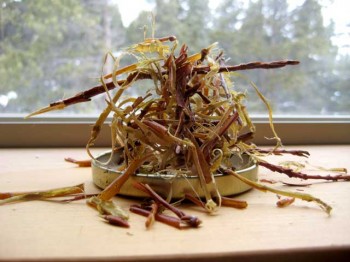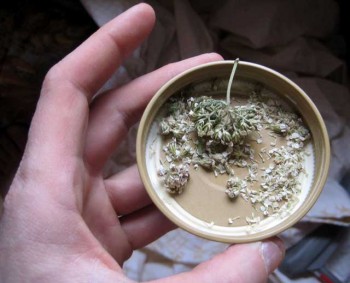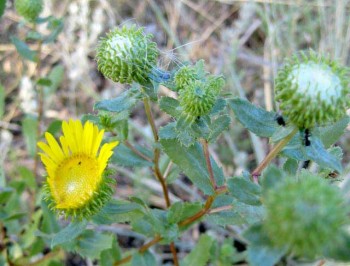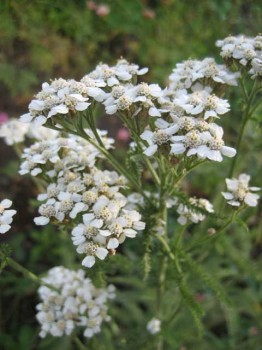
This is great—not only did I jump off a bush (on my snowboard) in an attempt to skip over some rocks to a mogul that turned out to be solid ice and hear my knee go “crunch,” such that I am suddenly confined to home awaiting an MRI, but I am also coming down with a cold, sore throat and cough and all.
But, please, don’t read “This is great” as sarcasm. I honestly feel blessed by the universe—for now, jobless once more, I have opportunity to test my wild medications upon myself, not to mention the free time to write about it.
I figure I’ll start with the cold today and save the knee for next week. After all, it seems a little foolish to mend bones and ligaments until one is certain they are arranged in the right place. At present my right knee cannot straighten to save my life (though in landing that leap three days ago it did flex very much in order to do so).

WildFoodGirl Disclaimer #75 or so
Before we go on, know that I am an unlicensed practitioner of wild medicine whose training has consisted of cross-referencing a few guides and talking to some people, combined with an inner foraging sense that I channel from days of yore like a laser. So with that in mind, take it from this dumbass who wrecked her body from high amplitude upon the solid ground, and be sure to use good judgment: If something herein piques your interest, by all means research it before attempting. Furthermore, if you are an expert and discover something insane on my internet weblog, then please comment and let us know post haste.
Home-Brewed Cold Meds
The wild-made cold meds in my cupboard include dried mullein (Verbascum thapsis), yarrow (Achillea sp.), and willow (Salix sp.) along with tinctures of elderberry (Sambucus sp.) and sticky gumweed (Grindelia sp.). I prepared these prior to obtaining the late Michael Moore’s definitive guide, Medicinal Plants of the Mountain West (2003), which, in addition to collecting tips and medicinal uses for plant parts also provides specific instructions, including proportions of alcohol and/or water to herbs for medicine-making, along with recommended dosages. As I was not privy to this information when I prepared my potions, however, I remain uncertain as to their strengths, which of course makes dosing an inexact science.
Still, the dried mullein and yarrow have come in handy for cold-soothing teas, the elderberry tincture for preventing or staving off the worst of it, the sticky gumweed tincture as an expectorant, and of course the yucky willow tea for pain relief when I can stomach the flavor.

Mullein, an Old World Medicinal
Granted, the prescription of hydro-codone acetaminophen now in my possession knocks me out more readily than the “slightly sedative” and “[pleasantly] bland” mullein tea, as Kathryn G. and Andrew L. March describe it in Common Edible and Medicinal Plants of Colorado (1979), but mullein is wild and free.
“An old world plant of ancient medicinal repute naturalized in America,” the March’s explain, mullein is a “gentle herb” excellent “to help one along and relieve sore throat and cough.” To make the tea, infuse dried or fresh leaves in hot water and then strain (I use a coffee filter) to remove the fine hairs. I take it with honey and milk, the latter combining with the mild-tasting tea to produce a pleasing opaque mint green color. If anything, it at least soothes the spirit.
Sweating it out with Yarrow
Yarrow tea, on the other hand, I enjoy much less. To me it tastes astringent, but of course every palate is different. One of yarrow’s many benefits is that it can be used to instigate sweating. Although this may not seem a desirable result, Moore explains that while some wild herbs provide “palliative relief” such as sedatives and laxatives, others act to “stimulate and even temporarily aggravate the body’s healing process.” Sweating, he explains, brings heat outward, cools the skin, and “speeds the excretion of waste products.”

Yarrow abounds in the Colorado high country in both wild and cultivated forms. Wary of insecticides, I have collected only wild varieties; two years ago I started with the leaves, followed by flowers and flower stalks after my Ukranian friend Olena shared how her grandmother would send her into the field as a child to collect them for medicine-making. Michael Moore says “the traditional method is to gather only flowers, but the upper stems and leaves actually retain their strength longer and should be kept along with the flowers.”
Brewing the tea is similarly simple: Just infuse dried or fresh plant parts in hot water, add honey as desired, strain out the pieces, and imbibe. “Use in moderation,” Moore advises, especially during pregnancy.
Willow Puts the “Ick” Back in Pain Relief
It can take a lot of willow bark for pain relief, explains Moore, who recommends a “strong decoction” of 2-4 ounces of willow bark up to 4x/day. At the same time, however, he reports great variability of potency from plant to plant.
Among other constituents, willow contains salicin, “the natural ancestor and equivalent of aspirin (acetylsalicylic acid),” according to the March’s, hence the similar pain-relieving properties. To me, willow tea is akin to liquid aspirin (awful!), though I suppose everyone (who is not allergic to aspirin or undergoing anticoagulant drug therapy or immunosuppressant organ-transplant therapy, per Moore) should try it at least once, if only as a way to train for the apocalypse.
Good as willow tea is for pain relief, I’d be lying if I said I pulled any out of the cabinet to deal with cold-associated headaches this time around. No, better yet I’ll save it, perhaps for a time when I’m feeling a measure more adventurous or masochistic.

Coughing it Up with Grindelia
Sticky gumweed (Grindelia) does not grow at my elevation, but I collect it down metro Denver-way whenever the opportunity presents itself. It’s a gooey, funny, flowering plant, with buds that present as cupfuls of medicinal resin ripe for the picking. These I immerse in vodka, bottle, and store in a dark place, jostling occasionally, for a month or so before straining out the plant parts and putting it away again for later use. Ryan Drum uses 1 part buds to 3 parts aqueous alcohol and then “5 drops tincture under the tongue or in strong hot steeped yarrow tea for treating coughs, colds, and flu.”
I am so thankful for the strong Grindelia tincture now and in the winter months in general, when I work myself to the bone while contracting illnesses from the publics I serve. These inevitably lead to dry, unproductive coughs in need of expectoration. “Grindelia is harmless in sensible amounts,” Moore reports, “so harmless that it is perfectly safe and useful for children.”
I gathered only half a pint’s worth this year, this time from Marilyn’s 93-acre ranch in Golden. Despite two colds under my belt already, however, the tincture has lasted, and with the knee injury I should see less exposure to human-borne illness until next year’s cold season anyway. (Does anyone want to come for a visit? It’s lonely up here on the hill.)
Elderberry Friendship Tincture
If you have friends, and your friends get colds, then the chances of catching one are good—unless, that is, you stave them off with elderberry tincture, a lesson I learned from my dear friend Butterpoweredbike.
Michael Moore writes: “Flowers and leaves of any species of Elder can be gathered and used interchangeably; only the berries differ. Red elderberries can be bitter and a bit toxic for some folks, so for gathering berries stay with the blue or purple species.” Alas, we have the now-dormant red ones growing outside the house, but no elderberries on the cooler side of the color wheel.
No, I owe it to Butter for introducing me to the blue-berry laden elder trees this fall, and for instructing me to pick them and make the tincture. It is to be taken in small but regular doses at the onslaught of a cold, she said, so I have been taking it like Airborne or Emergen-C. This particular cold, unfortunately, is already well underway, but I might go for it anyway.
“The most frequent use of elder is to stimulate sweating in dry fevers,” Moore explains, but now “Elderberries in various guises are being used as antivirals in Europe and, through alternative medicine, in this country as well.” Ricola cough drops have elder in them. Moore recommends straining out the seeds when making jams and wines of the berries, as the seeds “can contain mildly toxic substances.” Oops. I did not strain the seeds out of my first elderberry tincture. Next time, I guess.

Back to the Basics, Undaunted
Even as a modern girl not yet introduced to wild medicines I endeavored to take charge of my own healing—whether by making a cough syrup of finely chopped onions, garlic, honey and lemon, using steaming showers to sweat out a cold or a Neti pot to relieve my nasal passages. Something about doing something myself to make a difference has always appealed to me, in contrast to my sometimes fear of blindly ingesting synthetic drugs and trusting doctors who know little about me personally.
Moore says “drugs can save lives in serious, acute diseases and may alleviate or even cure some chronic problems, but they are very poorly suited for the vast majority of chronic and minor ailments,” especially drugs producing side effects that hinder the organism’s ability to heal itself, at times prescribed, he states, as “knee-jerk therapies” by “overworked physicians.” He does not advocate a total rejection of traditional medicine but rather the use of wild medicines according to “sensible guidelines” that produce “majority effects”—helpful to some but not all people seeking to alleviate or resolve specified ailments of a non-life-threatening nature.
Fear of wild medicines in our culture is a fear of the unknown—one that has been expressed to me personally in no uncertain terms by friends and family members as I delve deeper into this new pursuit—but I find that the more I learn about this fascinating subject, the less I fear, both in regards to wild medicines and in my own ability to heal myself. Hopefully yours is a similar experience.

Hey! I see that Gnu base! Hehe!
Hope you’re feeling better soon Erica-loo, not only from that cold but your knee as well, so that you may once again ride your snowboarding machine!
<3 Melissa
Noooooooo! What’s the update? How are you? Ohmyholyheck, do you need major doctoring? Email me. No wait, I’ll email you.
🙁
Yeah, I busted up my knee good. I had to trust me some doctors after all and am now healing up after a complicated 2.5 hour surgery. I’d have written more by now but between the pain and the drugs I am rather loopy.
Sorry for Gnu, Meliss–but it was like an ephiphany returning to it for small jumps and spins compared to next year’s B. Anyway, lest this become a snowboarding blog I’ll save the rest of my thoughts on that for another time. Doctor’s orders: Off snow for 10 months. Egad.
Erica, I’m emailing you! =) PS Any time you need to chat or even vent, I am always available, well at least I will be on Friday when I’m back in the US and not China.
Any idea where elderberry grows in the Littleton, CO area? I hike along the Highline Canal and South Platte but I think I’m seeing chokecherries rather than elderberries. I have found that taking elderberry extract, oral Zicam spray and EmergenC will stop a cold or other virus in its tracks. My highschool age son has thwarted at least 4 colds this winter with that combination and I’d love to make my own elderberry extract.
Hi Deb – I do not, but if I find some on one of my jaunts through the metro area, you’ll be the first to know. I will say this: When Butter showed me the elderberry trees, they were growing as landscaping where a yard met sidewalk. Not sure if that helps. If you want, visit her site (linked above), go to the Contact page, and give her a shout. She might have a better idea than I do at present.